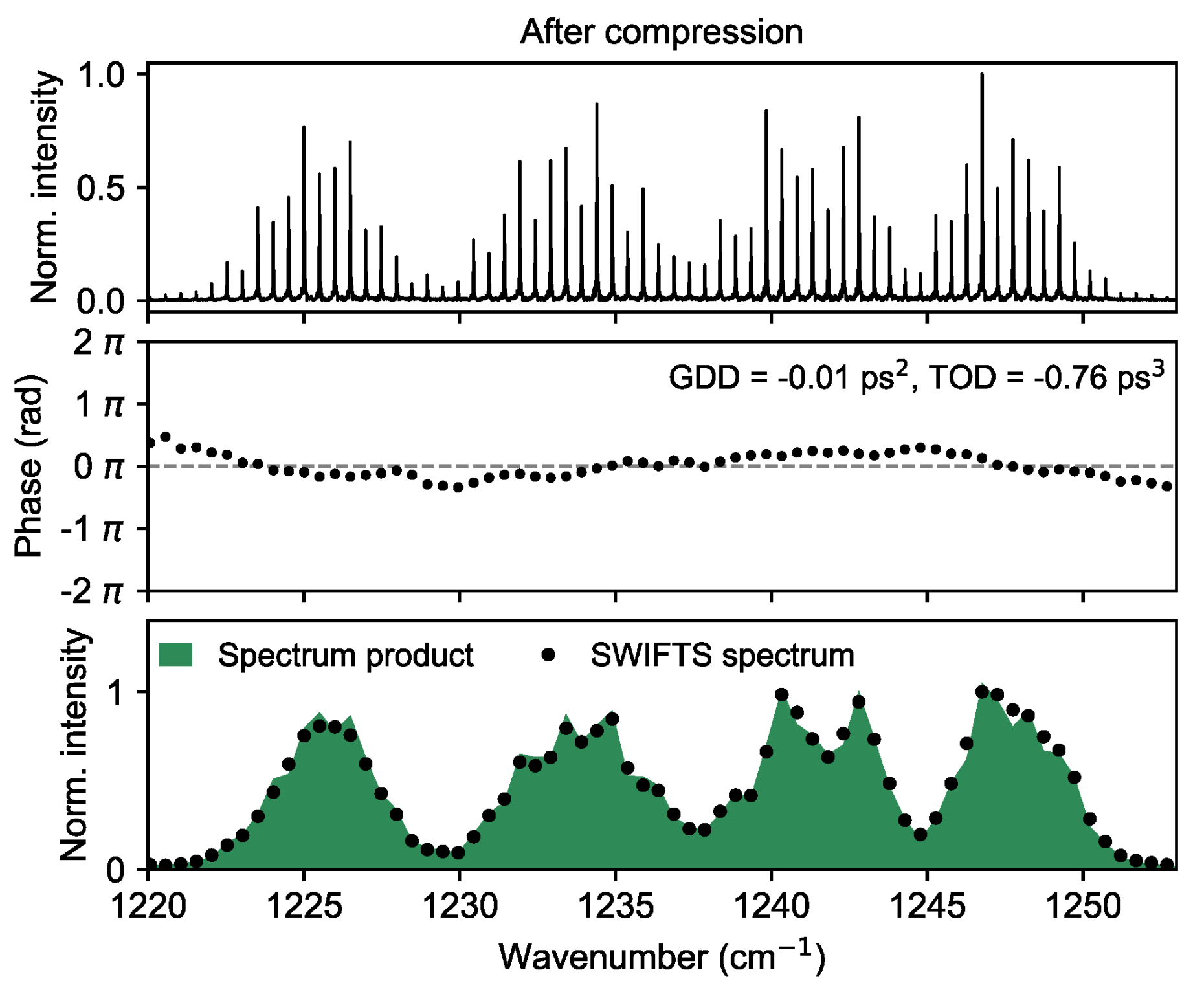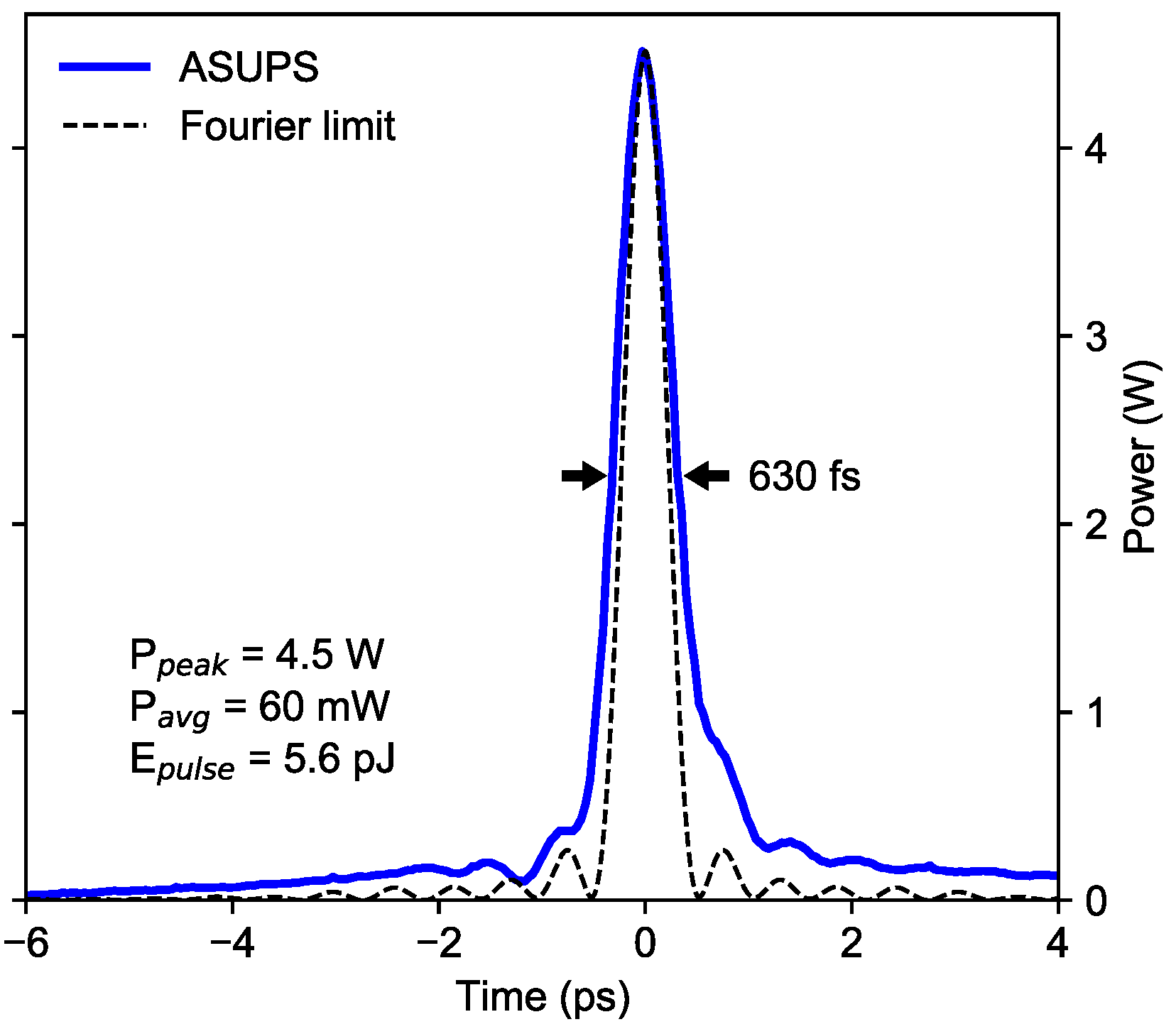Femtosecond QCL sources
Nowadays, ultrashort pulses are routinely generated in the visible to near-infrared using mode-locking1. Considerable efforts are aimed at shifting ultrafast laser technology also to longer wavelengths, to the so called molecular "fingerprint" region above 2.5 \( \mu m\)2. Today, ultrashort sources in this frequency range mainly rely on down-conversion processes of shorter wavelength mode-locked lasers in nonlinear materials. Such sources suffer from low conversion efficiencies and often reach tabletop scale. Moreover, the damage threshold of the involved nonlinear materials has become a limiting factor for generating high repetition rate high power laser pulses, as often desired for nonlinear spectroscopy applications3.
Quantum cascade lasers (QCLs)4 principally constitute ideal candidates for directly generating high-energy mid-infrared ultrashort pulses. They exhibit a low footprint, up to watt-level average power with a broad spectral bandwidth5,6 and the peculiarity that their emission wavelength can be tailored by adapting the quantum well dimensions. Moreover, they have proved to be phase stable, a result of the strong third order susceptibility inside the gain medium, enabling the generation of phase-locked frequency combs7. However, in contrast to typical mode-locked combs, QCL modal phases turn out to be mutually fixed but not constant, leading to a frequency modulated output instead of pulses7,8. This fundamental property of QCL combs can be ascribed to the short gain recovery time which is approximately one order of magnitude lower than typical cavity round-trip times9.
Generating optical pulses in such structures is an attempt of pushing the laser out of this favoured state. In the mid-infrared, active mode-locking was accomplished by strongly modulating a small section of the laser cavity close to the repetition frequency10,11,12. While available average powers were limited due to the onset of strong gain saturation, pulse durations as short as 3 ps were reported. Similar pulse lengths were demonstrated from actively mode-locked terahertz QCLs where mode-locking through gain modulation generally arises more naturally13,14,15.
In our group, we follow a different approach and take advantage of the unique properties of FM combs. Recent experimental8, 16, 17 and theoretical18,19 works show that QCL combs emit a field of almost quadratic phase alongside a quasi-constant intensity. This finding is intriguing, as it means that well-established compression schemes can be applied for external pulse formation. The pulse compressor used in our work is shown in Figure 1. By moving the second grating (G2) and retroreflector (M) with respect to the remaining setup the introduced group delay dispersion can be gradually tuned until a flat phase profile is reached (Figure 2).
In order to further decrease pulse durations, the QCL optical bandwidth can be increased via strong gain modulation at the repetition frequency. We use an adapted QCL design with a microstrip-like line waveguide geometry. Efficient radio-frequency coupling is then achieved using a coplanar probe20. Figure 3 displays the amplitude spectrum before and after gain modulation. We observe a significant increase in spectral bandwidth by approximately a factor of two.
The spectrally broadened and compressed QCL intensity profile is measured in an optical sampling experiment, schematically described in Figure 4. The QCL waveform, repeating at a round-trip frequency \(f_{rep}^{QCL}\), is asynchronously probed by 100 fs pulses from a mode-locked laser, whose repetition rate \(f_{rep}^{fs}\) is approximately two orders of magnitude lower than \(f_{rep}^{QCL}\). A slow detection system can thus be used to measure each of these samples and reconstruct the original QCL waveform once the ratio \(f_{rep}^{QCL}\)/\(f_{rep}^{fs}\) is precisely known.
Figure 5 displays the obtained results. We observe ultrashort 8\(\mu m\) pulses with a peak power of 4.5 W and a pulse duration of 630 fs. The pulses are near-transform-limited, as indicated by the pulse shape when compared to a pulse with constant phase profile and otherwise identical intensity spectrum.
See our publication on external page Arxiv or external page Nature Photonics for more details. A review of the article is also available and can be found external page here!
References
[1] Haus, H. A. Mode-locking of lasers. IEEE Journal of Selected Topics in Quantum Electronics 6, 1173–1185 (2000)
[2] Pires, H., Baudisch, M., Sanchez, D., Hemmer, M. & Biegert, J. Ultrashort pulse generation in the mid-ir. Progress in Quantum Electronics 43, 1–30 (2015)
[3] Cao, Q., Kärtner, F. X. & Chang, G. Towards high power longwave midir frequency combs: power scalability of high repetition-rate differencefrequency generation. Opt. Express 28, 1369–1384 (2020)
[4] Faist, J. et al. Quantum cascade laser. Science 264, 553–556 (1994)
[5] Jouy, P. et al. Dual comb operation of λ ∼ 8.2 µm quantum cascade laser frequency comb with 1 W optical power. Applied Physics Letters 111, 141102 (2017)
[6] Schwarz, B. et al. Watt-level continuous-wave emission from a bifunctional quantum cascade laser/detector. ACS Photonics 4, 1225–1231 (2017)
[7] Hugi, A., Villares, G., Blaser, S., Liu, H. C. & Faist, J. Mid-infrared frequency comb based on a quantum cascade laser. Nature 492, 229-233 (2012)
[8] Singleton, M., Jouy, P., Beck, M. & Faist, J. Evidence of linear chirp inmid-infrared quantum cascade lasers. Optica 5, 948–953 (2018)
[9] Choi, H.et al.Gain recovery dynamics and photon-driven transport inquantum cascade lasers. Phys. Rev. Lett. 100, 167401 (2008)
[10] Wang, C. Y.et al.Mode-locked pulses from mid-infrared quantum cascade lasers. Opt. Express 17, 12929–12943 (2009)
[11] Revin, D. G., Hemingway, M., Wang, Y., Cockburn, J. W. & Belyanin, A. Active mode locking of quantum cascade lasers in an external ring cavity. Nature Communications 7, 11440 (2016)
[12] Hillbrand, J.et al.Mode-locked short pulses from an 8μm wavelength semiconductor laser. Nature Communications 11, 5788 (2020)
[13] Barbieri, S.et al.Coherent sampling of active mode-locked terahertz quantum cascade lasers and frequency synthesis. Nature Photonics5, 306–313(2011)
[14] Wang, F. et al. Generating ultrafast pulses of light from quantum cascade lasers. Optica 2, 944–949 (2015)
[15] Wang, F. et al. Short terahertz pulse generation from a dispersion com-pensated modelocked semiconductor laser. Laser & Photonics Reviews 11, 1700013 (2017)
[16] Hillbrand, J., Andrews, A. M., Detz, H., Strasser, G. & Schwarz, B. Coherent injection locking of quantum cascade laser frequency combs. NaturePhotonics 13, 101–104 (2019)
[17] Cappelli, F.et al. Retrieval of phase relation and emission profile of quantum cascade laser frequency combs. Nature Photonics 13, 562–568 (2019)
[18] Opacak, N. & Schwarz, B. Theory of frequency-modulated combs in lasers with spatial hole burning, dispersion, and kerr non linearity. Phys. Rev. Lett. 123, 243902 (2019)
[19] Burghoff, D. Unraveling the origin of frequency modulated combs usingactive cavity mean-field theory. Optica 7, 1781–1787 (2020)
[20] Kapsalidis, F.et al. Mid-infrared quantum cascade laser frequency combs with a microstrip-like line waveguide geometry. Applied Physics Letters 118, 071101 (2021)




